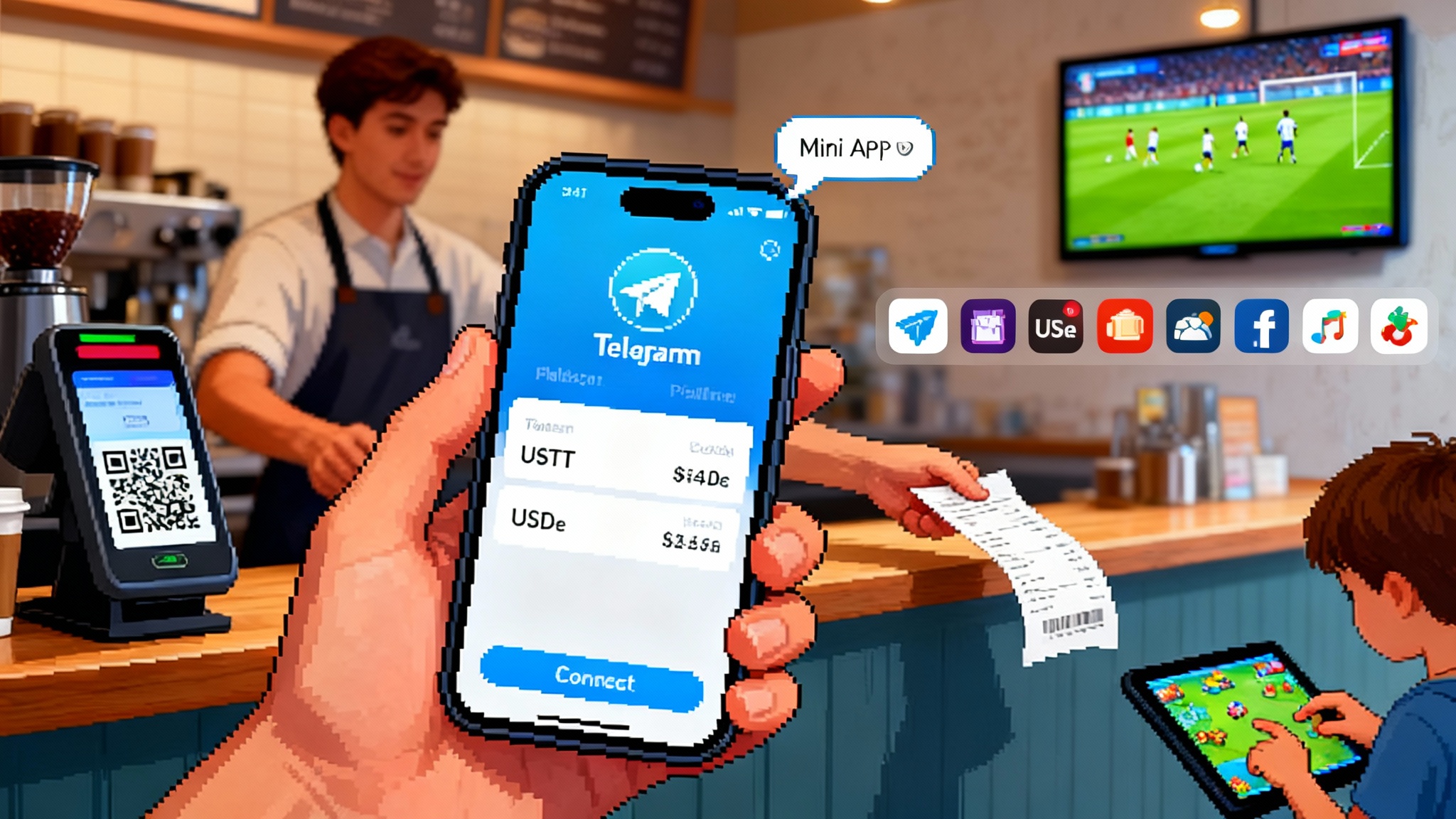Telegram’s TON Wallet begins U.S. rollout, Web3’s on-ramp
Telegram made TON the default chain for Mini Apps, integrated Ethena’s USDe, and started a U.S. wallet rollout. Here is why this distribution shift matters and how builders can capitalize right now.

The year Telegram turned distribution into the product
If crypto’s last decade was about building rails, 2025 is the year a mainstream app laid the track and opened the gates. On January 21, Telegram named The Open Network the exclusive chain for its Mini Apps, a decision that pulled fragmented experiments into one highway inside a billion‑user messaging app. The move was not a press release stunt. It set a default: if you are a developer who wants to plug a blockchain feature into a Telegram Mini App, you use TON, and you connect wallets with TON Connect. Telegram did not just bless a network. It set the rules of the road and the entrance ramp. See the announcement that TON became the exclusive chain for Mini Apps.
The second milestone landed on May 1, when Ethena’s synthetic dollar, USDe, began integrating across TON wallets and apps. That put yield‑bearing dollars next to chat, channels, and games, and it signaled a bigger goal: turn Telegram into a place where money is native. Not a browser tab away, not an extension waiting for a seed phrase, but the same surface where people already talk and trade.
The summer delivered the third beat. Telegram’s built‑in TON Wallet began a phased rollout in the United States, bringing a self‑custodial experience into a market that historically forced crypto to live in separate apps and browsers. The app did not try to reinvent people’s habits. It piggybacked on them. Users see a wallet in the menu they already open, send stablecoins to contacts like they send photos, and use Mini Apps without the ritual of copy‑pasting addresses or juggling sign‑ins. Coverage of the launch confirmed the wallet begins U.S. rollout in July.
Put those pieces together, and 2025 becomes the year Telegram created crypto’s most credible superapp on‑ramp. Not because it added a wallet, but because the wallet sits next to identity, social graphs, search, and distribution. That is what changes the physics. This sits alongside broader payment momentum, including the rise of onchain dollars go retail analysis.
Why the distribution shift matters
-
One billion users, one stack. Fragmentation kills mainstream adoption. Telegram’s choice to standardize Mini Apps on a single chain and wallet connect protocol turns discovery and onboarding into muscle memory rather than a guessing game. In practice, this means a food delivery Mini App and a game handle sign‑in and payments the same way. Consistency cuts support tickets and increases conversions.
-
Payments where conversations happen. USDT now lives on TON. USDe is integrating. That gives users a stable unit of account for pricing and payouts, and a yield‑bearing dollar for savings inside the same app. Instead of pushing people to exchanges, the wallet supports peer‑to‑peer transfers, swaps, and fiat ramps. Messenger‑native payments are how WeChat changed Chinese retail; Telegram is attempting a similar embedding for web3. For context on consumer payments going crypto native, see our onchain dollars go retail analysis.
-
On‑chain identity that is not alien. TON Connect lets a user sign a message from their wallet so an app can recognize the same person tomorrow. It is not a username and password. It is a cryptographic handshake that proves control of an address. When apps adopt it, a user’s history, balances, and entitlements move with them across Mini Apps, which is what a real platform feels like.
-
Creator economy with real exits. Telegram Stars, the in‑app currency used for Mini App purchases and tips, can be withdrawn as Toncoin. That links the content economy that already exists in channels and bots to an on‑chain settlement rail. It also sets a clean template for revenue splits and transparency.
This is not another wallet launch. It is a distribution strategy that rides on two things other crypto products lack: an existing daily habit and a consistent user interface.
From chat thread to checkout
Imagine a gaming studio shipping a Telegram Mini App. The studio does not need to teach seed phrases on day one. The game starts in guest mode, asks the player to connect a wallet when they want to trade or withdraw, and prices in‑game items in Stars or USDT. When a creator sells a limited item to a channel, the checkout is the same flow. When a friend pays another friend back for dinner, the chat thread itself is the address book. All of this works because the wallet, identity, and payments live inside the app where the conversation already happens.
The practical outcomes are simple:
-
Remittances behave like messages. Migrant workers can send USDT on TON to family in seconds. Recipients do not need an exchange account, only Telegram. Fees and friction go down, speed goes up.
-
Microcommerce becomes chat‑native. Sellers can drop a Mini App or a checkout link in a channel, price items in Stars or stablecoins, and settle to Toncoin. Refunds, upgrades, and subscriptions can run as smart contracts with a familiar front end.
-
Games monetize like apps, not like tokens. Instead of designing a token economy first, teams can start with gameplay. They add ownership and marketplaces later, using the wallet flows users have already seen in other Mini Apps.
The builder playbook for 2025
If you are building on Telegram now, you are not shipping a wallet. You are shipping flows. Here is a practical, fast‑moving playbook that teams are using to get from idea to production in about 60 days.
- Choose your Mini App flows
- Start with chat‑first entry points: deep links from posts, pinned messages, or channel menus. Optimize the first 10 seconds to load fast and explain value in plain language.
- Offer guest mode and defer wallet connection until the user wants to buy, trade, or withdraw. Add a single call to action: Connect to unlock saving or spending.
- Use TON Connect for sign‑in. Request the minimum scope to start. If you need a verified identity later, escalate with a second prompt and a reason.
- Compliance and know your customer, without breaking the UX
- Pick the right custody model for your risk profile. If you need card acceptance or stablecoin off‑ramp in regulated markets, partner with a custodial wallet provider that can perform know your customer checks and transaction monitoring. If you are building a marketplace or game with minimal money movement, default to non‑custodial and add optional top‑ups.
- Build a two‑lane policy. Lane one serves the United States and other strict jurisdictions with custodial flows and clear terms. Lane two serves the rest of the world with non‑custodial flows. Detect the jurisdiction, present the right lane, and document the differences. For the U.S. backdrop, watch the CFTC and SEC spot trading shift.
- Offer clear disclosures inside the app. Explain custody, fees, and refund policies before the user connects a wallet.
- Fiat ramps that feel invisible
- Integrate at least two on‑ramps to avoid single points of failure. Consider providers that support Apple Pay and Google Pay for instant purchases, bank transfers for larger tickets, and card off‑ramps for refunds and payouts.
- Pre‑fill on‑ramp amounts based on cart value. If the user lacks enough USDT or Toncoin, offer a one‑tap top‑up, then return them to the checkout without losing state.
- Stablecoins by default
- Price everything in a stable unit. Use USDT on TON for day‑to‑day payments and balances. Add USDe when you want to offer dollar savings or loyalty tiers that accrue a reward rate. Separate the payment balance from the savings balance so users do not overspend what they intend to earn on.
- For creators, route Stars revenue to Toncoin automatically, with optional rules to convert a percentage into USDT or USDe for tax and savings.
- Cross‑chain deposits with LayerZero
- Many users hold stablecoins on other networks. Use LayerZero routes to let a user bring USDT or USDe from Ethereum or Tron into TON without teaching bridges. The right pattern is intent based. Ask what they want to spend, where funds live now, and perform the transfer and swap under the hood. Present a single progress bar and a single receipt.
- Support and recovery the way users already understand
- Ship a help Mini App for your product. Support is a chat with context, not an email address.
- For non‑custodial users, offer multiple recovery options. Support split key backups, hardware wallets for power users, and clear reset flows for those who choose custodial accounts. Never gate support on a seed phrase screenshot.
- Data, not vibes
- Instrument every step. Track where users drop, how often they connect wallets, which on‑ramp flow converts, and how many abandon at know your customer. Build dashboards before you ship your first campaign.
Metrics that will tell you if this is working
-
U.S. daily active users in wallet. Count unique U.S. users who open the wallet or approve a transaction in a day. Segment by iOS and Android to monitor app store policy risk.
-
Wallet activations per week. Measure the rate of new non‑custodial wallets created inside Telegram. Pair it with first transaction time to see if activations lead to use.
-
Stablecoin supply on TON. Track USDT and USDe circulating on TON, plus the share held inside Telegram‑connected wallets. Supply without velocity does not help. Watch transfers per address and average holding period.
-
Mini App gross merchandise volume. Record the total paid volume across your app, broken down by Stars, USDT, and USDe. Add refund rate and dispute rate to catch fraud early.
-
Connect‑to‑purchase conversion. For commerce, measure the share of users who complete a purchase within one session after connecting a wallet.
-
Game retention. For games, track day 1, day 7, and day 30 retention for users who played at least one on‑chain session. Compare wallet‑connected users against guests.
-
Cost to acquire a wallet‑connected user. Include ad spend, creator payouts, and on‑ramp incentives. If this number trends below your average in other channels, scale Telegram inventory first.
Near‑term risks you should expect, and how to hedge them
-
App store policy shifts. If Apple or Google tighten rules on in‑app crypto, two things help. First, keep a web fallback for every critical flow, especially checkout and wallet funding. Second, and convert to Toncoin or stablecoins outside the store context for payouts.
-
U.S. regulatory scrutiny. Avoid wishful thinking. Respect state by state differences. If you are moving dollars for U.S. users, work with partners that hold the right licenses, keep know your customer and anti‑money‑laundering controls, and offer clear disclosures. For non‑custodial flows, never make implied guarantees about recoverability or price. For the broader policy picture beyond Telegram, see tokenised funds momentum in the UK.
-
Custodial and non‑custodial confusion. Users do not care about architecture. They care about whether money is safe and accessible. Label the mode clearly. If you custody funds, say so and explain how to withdraw. If the user holds keys, say that too and offer optional safety nets such as social recovery or split keys.
-
Stablecoin and synthetic dollar risk. USDT is liquid. USDe offers a reward rate and uses a different design. Give users a simple choice card with pros and cons in plain language. For savings, default to conservative allocations and cap rewards on promotional campaigns so they do not look like promises.
-
Identity sprawl. Signing with TON Connect proves address control, not who someone is. For higher risk features like peer‑to‑peer lending or large payouts, add an optional identity verification step and bind it to the wallet address, then reuse it across your Mini App portfolio.
-
Bridge and cross‑chain risk. Even with LayerZero, treat cross‑chain transfers as higher risk. Show clear progress, include reversal paths, and limit maximum amounts for first‑time users. For big tickets, route users to bank transfers into a custodial balance.
What success could look like by 2026
Two simple pictures. First, everyday U.S. users treat Telegram like a finance tab, not a crypto experiment. They pay a friend back in USDT without thinking about gas, and they hold a small USDe balance because it earns. Second, builders treat Mini Apps as a primary channel. They launch in Telegram first because it converts, because users already know the flows, and because identity, payments, and distribution live in one place.
The ingredients are in place. Telegram standardized the stack on TON. Stablecoins and synthetic dollars are inside the same surface as chat. A U.S. rollout brought the wallet to one of the hardest markets. If you are a builder, the play is to design around the flows the platform just normalized. If you are a user, the test is whether paying, saving, and playing inside Telegram feels obvious after a week. If both happen, we will look back at 2025 as the year crypto finally shipped where people already are.








